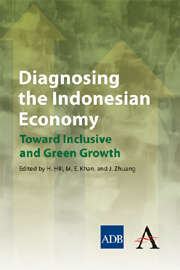Book contents
- Frontmatter
- Foreword
- Preface
- Author Profiles
- Abbreviations and Acronyms
- Contents
- 1 Introduction
- 2 Development Policies and Performance
- 3 Critical Constraints to Growth
- 4 Critical Constraints to Reducing Poverty and Inequality
- 5 Macroeconomic Management
- 6 Industrialization: Patterns, Issues, and Constraints
- 7 Infrastructure Development: Challenges and the Way Forward
- 8 Human Capital and Economic Development
- 9 Economic Growth, Employment Creation, and Poverty Alleviation
- 10 Poverty Reduction: The Track Record and Way Forward
- 11 Decentralization
- 12 Making Indonesia's Growth Green and Resilient
- Index
2 - Development Policies and Performance
Published online by Cambridge University Press: 05 May 2012
- Frontmatter
- Foreword
- Preface
- Author Profiles
- Abbreviations and Acronyms
- Contents
- 1 Introduction
- 2 Development Policies and Performance
- 3 Critical Constraints to Growth
- 4 Critical Constraints to Reducing Poverty and Inequality
- 5 Macroeconomic Management
- 6 Industrialization: Patterns, Issues, and Constraints
- 7 Infrastructure Development: Challenges and the Way Forward
- 8 Human Capital and Economic Development
- 9 Economic Growth, Employment Creation, and Poverty Alleviation
- 10 Poverty Reduction: The Track Record and Way Forward
- 11 Decentralization
- 12 Making Indonesia's Growth Green and Resilient
- Index
Summary
Introduction
During the past half century, Indonesia has experienced pronounced swings in its development policies, priorities, processes, and outcomes, on a scale matched by few other developing countries. For these reasons, economic historians tend to characterize its development as one of missed opportunities (Booth 1998, Dick et al. 2002). The key dates are March 1966, signaling the transition from Sukarno to Suharto, and May 1998, when Suharto stepped down in the face of widespread public protests and the country abruptly swung from authoritarian to democratic rule.
Thus, from 1960 to 2010 there were three distinct periods. The first of these, the remaining years of the ”Guided Economy,” is not covered in any detail in this volume, but it is useful to be cognizant of them. They were characterized by economic stagnation, hyperinflation, and growing political instability. The country was increasingly isolated regionally and internationally. The government withdrew from most international organizations, vowed to crush the newly formed state of Malaysia, and saw its priorities increasingly aligned to the so-called “Beijing–Pyongyang–Ha Noi–Phnom Penh–Jakarta axis” and other “new emerging forces.” The leading economic development textbook of the period characterized the country as a “chronic economic dropout,” and saw little prospect for economic development (Higgins 1968). Gunnar Myrdal's (1968) Asian Drama off ered a similarly gloomy prognosis. The country's development plan for the period 1960–1968 had 1,945 paragraphs, 17 chapters, and 8 volumes to symbolize the country's independence date.
- Type
- Chapter
- Information
- Diagnosing the Indonesian EconomyToward Inclusive and Green Growth, pp. 13 - 32Publisher: Anthem PressPrint publication year: 2012

